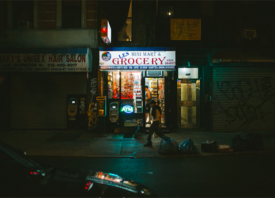Search this site
Tips on Landing Lucrative Influencer Marketing Jobs from the Pros

A few months ago, I was on vacation in Bali, a popular influencer playground, where it’s nearly impossible not to run into someone photographing or filming content. While sitting in a popular cafe in Ubud, I witnessed multiple influencers wandering around the restaurant. It was entertaining to watch and I was surprised to find that it brought up some mixed emotions for me. Even though I was enjoying the same cafe, I couldn’t help but feel a bit of FOMO for what I imagined was a life of travel, perks, and most importantly, sponsorship by brands.
In researching this article, I’ve come to find out that brands are looking for all types of people to help market their products, not just 20-somethings armed with fashion, travel and beauty tips (although these categories are still very popular).
And you don’t need to have thousands of followers to be an influencer. To get started with one of the agencies we interviewed for this article, you actually only need a thousand engaged followers. Which is not to say it’s easy to make a living doing this. There is a lot of competition. But if you have a niche and good engagement, read on for our tips from top influencer marketers Permele Doyle, Tiffany Romero, Lara Daniel and Alessandro Bogliari on how to break into this world.
What do you look for in influencers you choose to work with on behalf of your brand clients?
Permele Doyle, the co-founder and president of Billion Dollar Boy: First and foremost, it’s important to make sure that the influencer’s content aligns with the brand’s values and target audience—-and also with the brand’s overall look, feel, and tone.
The influencer should have a genuine interest in the brand and its products or services, as well as a strong understanding of and alignment with the brand’s messaging. Choosing an influencer who aligns well with the brand’s goals and values and has a genuine connection with their audience is always key to success.
We also seek out the most creative influencers. Influencer marketing is all about creating engaging and innovative content, so we look for influencers who bring new ideas to the table.
Tiffany Romero, the president of influencer management at the digital advertising agency Sway Group: Any creator with 1000+ followers on a platform is welcome to join our network at massivesway.com. Once you know you are posting regularly and have at least a thousand followers, that’s a good time to put yourself into the network.
When selecting a creator for a paid campaign, we consider the client’s requests, which may include demographic, following, and engagement. We also consider the quality of the content.
Additionally, it’s important that an influencer’s sponsored content does well. You will see people who have organic content that does really well, but the minute they talk about something that’s sponsored, it doesn’t. If it doesn’t do well, it’s usually because it’s not a good match. We look at what organic content has done well and consider whether or not the brand makes sense for the audience that’s engaging with that organic content.
Are there specific numbers or engagement metrics someone must have to be considered?
Doyle: There are no hard and fast rules about the exact numbers or engagement metrics an influencer should have to be considered. Generally, influencers with larger followings and higher engagement rates tend to be more desirable for brands, but other factors such as niche focus, quality of content, and level of authenticity should also be taken into account.
We typically classify influencers with more than 10,000 followers on platforms like Instagram or TikTok as micro influencers, and those with over 100,000 followers as macro influencers. Engagement rates of 2-3% are generally considered good and we look for at least this rate in influencers we partner with.
Romero: We like to see engagement over 3-4% for smaller creators and 2% for larger ones.
We have a lot of photographers on our email list, and many have tens of thousands of followers on Instagram. If they want to attract brands, what advice would you offer them?
Doyle: One of the best ways to attract brands to work with you is to build a strong and diversified portfolio of your work. Do this not only on your site but on your social channels.
Specialize in a niche, but show your breadth. Brands often look for photographers who specialize in a particular niche or industry, such as fashion, food, or travel. You can become an expert in that space and attract relevant brands. But if you predominantly show one niche on your channels, brands will think that is all you do. Use Instagram to show your range; can you shoot food or product? Can you shoot people? This will open up more opportunities.
Do your best to grow your following on your social accounts engaging with your audiences, using hashtags, participating in some social trends, etc. Brands do look at follower count and engagement. It’s also important to share branded content on your social channels so brands don’t think you only do editorial shoots.
Work to establish and build relationships with marketing managers, brand managers, and other photographers to help you network and find new business.
Lara Daniel, the co-founder and CEO of Pulse Advertising: For photographers looking to attract brands, focus on showcasing your unique style, creativity, and storytelling abilities. It’s crucial to create a strong portfolio that highlights your skills and expertise. Additionally, actively engage with the photography community, participate in relevant collaborations or competitions, and leverage platforms like Instagram to share your work, engage with your audience, and establish a strong personal brand.
Alessandro Bogliari, the co-founder and CEO at The Influencer Marketing Factory: Apart from having your own personal style, try to be in front of the camera as well. If you’re always behind the camera, you might have fantastic pictures, but it is going to be very difficult to understand who you are. You want to be recognizable, and you want people to associate your message with your face. One way to do this would be to start recording video tutorials or BTS showing your process.
Do you have any tips for how influencers should go about approaching brands directly?
Romero: I think that the best way to do it is to already be a loyal fan of the brand: following them, engaging with them, sharing the experiences that you’re having. Get on their radar by engaging with their social and tagging them in any content you create that features their products.
Oftentimes, it boils down to knowing that maybe they have a new product coming out that would be a perfect fit for your audience and reaching out to them and letting them know why it would be a fit.
Don’t just send a blanket email with a media kit attached. That’s usually just gonna get put in a pile. Instead, consider something like, ‘I’m so excited about the new product coming out, and I wanna share with my audience.’
And then, list out what you would offer (for example, two posts). Make it an easy ‘yes’ for them. Include your fee, any exclusivity you’re willing to offer, licensing you’re willing to offer, and so on, so that they have a really clear picture of what working with you would look like.
Daniel: Do your research. Understand the brand’s values, target audience, and existing influencer partnerships. Personalize your approach, and craft a tailored pitch that demonstrates your understanding of the brand and showcases how your collaboration can add value.
Don’t be overly transactional. Build a genuine relationship by focusing on the mutual benefits and long-term potential rather than just emphasizing compensation. And don’t be pushy. Respect the brand’s decision-making process and timelines, and be patient in your follow-ups.
On Instagram, do brands still want posts, or do they mainly ask for Reels?
Doyle: We’ve seen a big shift to video content on Instagram—virtually 80 to 100%. However, still photography still has an important place in brand marketing campaigns. For example, some brands are looking for high-quality still photos for use on their website, social or other channels (think retail and product packaging… the possibilities are endless.) Influencers who can produce both still photography and video content are attractive to brands as they can offer a wider range of content.
Bogliari: I would say that Reels and Stories are more in the spotlight these days because static posts are having less organic reach. With posts, you’re hoping that it’s going to be seen by maybe 3% of someone’s followers. But with Reels, you can start with 10,000 followers and then have that video seen by a million people, so it’s definitely more interesting for brands.
Are there any gaps that you’re looking to fill in your network?
Romero: We’re always looking for male creators. We’re always looking for diversity, whether that’s women of color, members of the LGBTQ+ community, and so on. We’re always looking to really round out the list and make sure that real life is represented very well on the list for clients.
What are some common mistakes you see influencers make, and how can they be avoided?
Romero: I think a lot of people don’t realize that how easy or not-so-easy you are to work with plays into getting the next job, as well as negotiating rates. Turning in your work on time, shockingly, is something that we have to consider and deal with on every single campaign, as well as people just going MIA. We always hire alternates, and we often use the alternates.
I also think that creators need to be thoughtful about sharing very controversial information when they wanna work with brands. Especially sharing something that maybe isn’t factual or needs to be fact-checked, as that has happened. It’s important to know the brand’s culture and that it matches your values. That’s an easy Google search.
Doyle: Lack of authenticity or misalignment with the brand’s values is a mistake, as is poor communication, unprofessional behavior, or failure to meet agreed-upon deliverables or deadlines. Inconsistent content quality or low engagement rates are red flags. Also, overly sales-focused content tends to lack genuine value for the audience.
We hear a lot of marketers use the word “authenticity,” especially in influencer marketing. What does that actually mean and look like?
Romero: I think for me, as someone who looks at influencers and creators every day, there’s a difference between being authentic and what some people think it means. People think it means you have to share every aspect of your life, and it doesn’t. You can have a private life and still be an authentic influencer.
But I think jumping niches regularly is something that I see—and that definitely comes across as inauthentic. For example, you see people go all in to be a makeup and fashion influencer and then they realize, oh, but I wanna go on a free trip, so now I’m gonna be a travel influencer. That doesn’t work because then you’re talking about things that just don’t match what your audience is expecting from you.
Additionally, I think we’re starting to leave the days of the perfect static post with, you know, the three children perfectly arranged in the clean white kitchen without a cup in sight. And we’ve moved more towards real-life raw videos, which is why I think TikTok is having so much success right now.
Do you have any more advice for creating sponsored content that resonates online?
Bogliari: When it comes to influencers, a lot of the time, you don’t buy just because of the product. You buy because you trust the person and you like the type of style and storytelling. It shouldn’t be only about the product—but about how you use it. Maybe sometimes you can use it in a different way. Think: how can you actually create a story around it?
About the experts:
Tiffany Romero is the President of Influencer Management at Sway Group, a full-service influencer marketing agency. She is a savvy marketer with years of experience leveraging the brand/influencer relationship. Romero has been featured in the New York Times, CBS, Huffington Post, ABC News, MediaPost, and Today’s Leading Woman.

Permele Doyle is the Co-Founder and President of Billion Dollar Boy. Billion Dollar Boy is a global influencer marketing agency creating award-winning influencer-led advertising campaigns, with a team of 150 influencer marketers across five offices.

Lara Daniel is the Co-Founder and CEO of Pulse Advertising, a market-leading influencer marketing agency. Leading a global team of 100+ employees, Lara Daniel combines her marketing acumen with business expertise to establish partnerships with brands including LVMH, L’Oréal, BMW, Ferrero, Hugo Boss, and more.

Alessandro Bogliari is the Co-Founder and CEO of The Influencer Marketing Factory, a global influencer marketing agency that helps brands launch influencer marketing campaigns On TikTok, Instagram, and YouTube. He is also a member of the Forbes Agency Council and a member of The Drum Network.
Further Reading:
• 14 Influencers Talk About Their Most Popular Image on Instagram
• Whimsical Paper Cut Outs Lead to Instagram Stardom, World Travel



